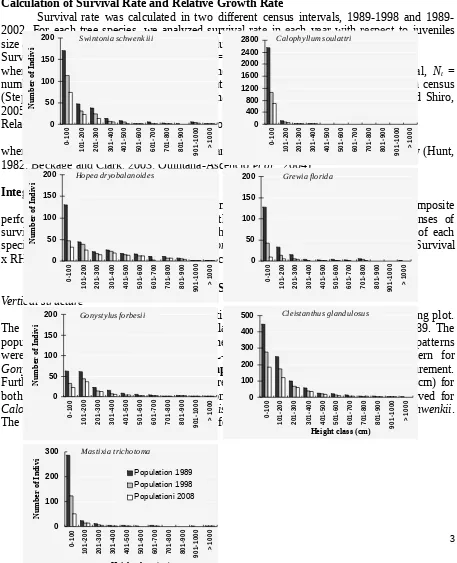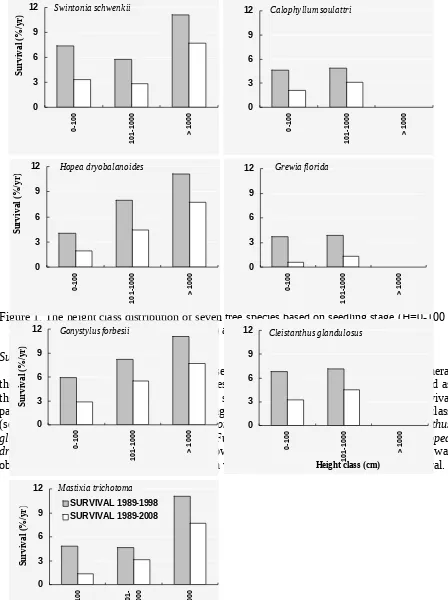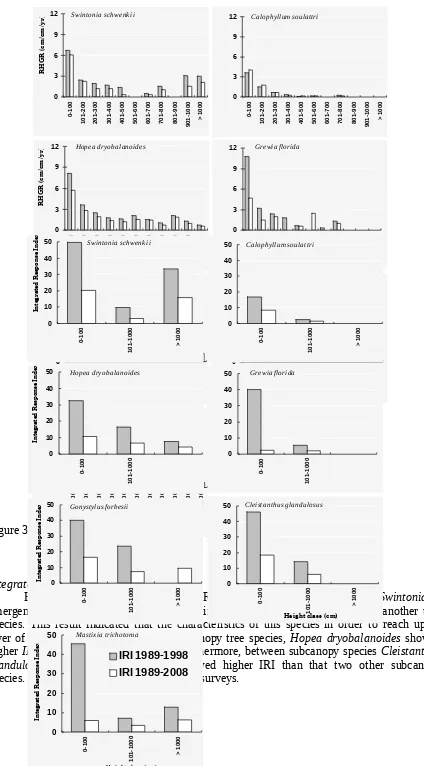ARTIKEL ILMIAH
PROGRAM PENELITIAN FUNDAMENTAL DI PERGURUAN TINGGI TAHUN ANGGARAN 2008
JUDUL
STRATEGI REGENERASI DARI BEBERAPA ANAKAN
POHON SETELAH PEMBALAKAN LIAR DI BUKIT
PINANG-PINANG DAN PERANANNYA DALAM UPAYA
MEREHABILITASI HUTAN YANG TERDEGRADASI
OLEH
Dr. Erizal Mukhtar, MSc
Dibiayai oleh :
Direktorat Jenderal Pendidikan Tinggi
Departemen Pendidikan Nasioanl
Sesuai dengan Surat Perjanjian Pelaksanaan Pekerjaan Penelitian
Nomor: 005/SP2H/PP/DP2M/III/2008
Tanggal 6 Maret 2008
FAKULTAS MATEMATIKAN DAN ILMU PENGETAHUAN ALAM
UNIVERSITAS ANDALAS
PADANG
2008
Survival and Growth of Several Important Juveniles Tree Species in a
Tropical Rain Forest, West Sumatra
Erizal Mukhtar
Department of Biology, Faculty of Mathematics and Natural Sciences, Andalas University, Padang 25163, West Sumatra, Indonesia
ABSTRACT
Survival and Growth rate of juveniles tree species in a tropical rainforest, West Sumatra, was measured for seven tree species over 13 year period in 1-ha plot of tropical rain forest in Ulu Gadut, West Sumatra, Indonesia. All individuals with dbh < 8 cm were sampled in 1989-1998 and 2002. The highest Survival rate of seedling was observed for Swintonia schwenkii and followed by Cleistanthus glandulosus and Gonystylus
forbesii. The lowest survival rate was observed for Grewia florida. Relative Height Growth Rate (RHGR)
were various between emergent, canopy and subcanopy tree. The highest RHGR was observed for emergent tree species, S. schwenkii. Whereas between canopy species, Hopea dryobalanoides was showed higher RHGR than Calophyllum soulattri. Furthermore, S. schwenkii as emergent tree species showed highest performance in Integrated Response Index (IRI). The relationship between their performances in the forest stand was also discussed in this paper.
Key Words : Survival, RHGR, IRI, seedling, Ulu Gadut forest.
INTRODUCTION
Regeneration is a key process for the existence of species in the community. It is also a critical part of forest management, because regeneration maintains desired species composition and stocking after biotic and abiotic disturbances. Various studies on regeneration of trees have been carried out in survival and growth. For example, the rate of forest regeneration depends largely on the growth rates and survival of native species that are planted or arrive on their own (Clark et al., 1999; Quintana-Ascencio et al, 2004) and large differences in seedling growth and survival of several species in response to spatial heterogeneity in microenvironments (Beckage and Clark, 2003).
We have monitored the population of major species at 1-ha permanent plots of a foothill rain forest in Ulu Gadut, West Sumatra since 1980. Spatial distribution pattern of major species in this forest have been revealed and their regeneration mechanisms were discussed with demographic data (Suzuki & Kohyama, 1991; Kohyama et al., 1994; Mukhtar
et al., 1992, 1998). This study follows the above previous paper observing the regeneration
mechanisms of several tree species in respect to their survival and growth rate. We aimed to clarify species characteristics survival and growth rates of juveniles in differences stage of the major tree species in this forest.
MATERIALS AND METHODS
Study site
This study was carried out at 1-ha permanent plot, named Pinang-pinang plot in a foothill forest of Mt. Gadut (Lat. 0o 55’ S, Long. 100o 30’ E), 18 km east from Padang, West Sumatra,
Indonesia. The elevation ranged from 490 m to 520 m in altitude. This plot is covered primarily by matured trees occurring in patches with sporadic gap and regrowth patches. Details of stand descriptions could be referred to the previous papers (Kohyama et al., 1989; Yoneda et al., 1990; Mukhtar et al, 1992; 1998)
Study species
We chosen 7 species which all these species are common and dominant in Ulu Gadut forest floor. The species were Swintonia schwenkii T & B (Anacardiaceae), Calophyllum
soulattri Burm (Guttiferae), Hopea dryobalanoides Miq. (Dipterocarpaceae), Cleistanthus
glandulosus Jabl. (Euphorbiaceae), Mastixiatrichotoma Bl. (Cornaceae), Grewia florida Miq.
(Tiliaceae) and Gonystylus forbesii Gilg. (Thymelaeceae). The species characteristics of seven tree species in forest stand are shown in Table 1.
Observation for seedling dynamics
All juveniles selected tree species were measured and mapped into a grid of 115 sub-plots of 10 x 10 m. The trees were marked and the species were identified. In September 1989, we were carried out first census of individuals for representative tree species in the plot permanent. The juveniles were re-sampled on September 1998 and on September 2002 in a second and the third census, respectively. Their positions and tree height were also measured at the first census and it recorded position make easily for next measurement.
Calculation of Survival Rate and Relative Growth Rate
Survival rate was calculated in two different census intervals, 1998 and 1989-2002. For each tree species, we analyzed survival rate in each year with respect to juveniles size and distance to the nearest conspecific adult.
Survival rates were determined as : Survival = (Nt/No)/ ∆t x 100 %
where No number of population count at the beginning of the measurement interval, Nt =
number of emerged among the initial population, ∆t = measurement interval between census (Stephanie and Jean-Francois, 2000; Quintana-Ascencio et al., 2004; Munemitsu and Shiro, 2005).
Relative Height Growth Rate (RHGR) could obtained by the following formula :
RHGR = [ ln Ht1 – ln Ht2 ]/ ∆t
where Ht1 and Ht2 are juvenile height in t1 and t2, and the duration (∆t), respectively (Hunt,
1982; Beckage and Clark, 2003; Quintana-Ascencio et al., 2004).
Integrated Response Index
In order to assess relative establishment success among the species, a composite performance index was used to integrate the contributions of regeneration responses of survival and growth. The relative value of the index indicates the expected success of each species at their habitat. The Integrated Response Index (IRI) was calculated as IRI = Survival x RHGR (De Steven, 1991; Quaintana-Ascencio et al., 2004).
RESULTS Vertical structure
Figure 1 is shown the height distributions of seven tree species in Pinang-pinang plot. The result shows a time trend of the population number during 13 years since 1989. The population was decreased gradually as the height class increased. The distributions patterns were founded majority (six species) in L-shaped whereas the distribution pattern for
Gonystylus forbesii were changed to Bell-shaped at the second and third census measurement.
Furthermore, the numbers of population were dominant at seedling stage (H=0-100 cm) for both census interval. The highest population number at seedling stage were observed for
Calophyllum soulattri and followed by Cleistanthus glandulosus and Swintonia schwenkii.
The lowest population number was observed for Grewia florida.
Figure 1. The height class distribution of seven tree species based on seedling stage (H=0-100 cm), sapling stage (H=101-400 cm) and pole stage (H=400-1000 cm)
Survival rate
Survival rate was differences among seven tree species as shown in Fig. 2. In general the result showed that survival rate was highest in the seedling stage and rapidly increased as the height class increased. Among seven tree species studies showed that the similar survival pattern between two interval censuses. The highest survival was observed in small height class (seedling, < 100 cm in height) for Swintonia schwenkii and followed by Cleistanthus
glandulosus and Gonystylus forbesii. Furthermore, Calophyllum soulattri, Hopea
dryobalanoides and Mastixia trichotoma showed intermediate. The lowest survival rate was
observed for Grewia. The survival rate pattern was also similar for the second census interval.
Figure 2. Frequency distribution of survival rate for seven tree species in two different census interval.
Growth rate
In general Relative Height Growth Rate (RHGR) was decreased as the hight class increasead as shon in Figure 3. The highest RHGR was observed for Grewia florida for the first census interval but at the second census interval the rate become lowest one. At the second census interval the highest RHGR was observed at Swintonia schwenkii. Furthermore,
Hopea dryobalanoides, Gonystylus forbesii, were showed intermediate in both interval census.
Mastixia trichotoma showed higher RHGR at first census but showed the lower one at the
second census. From these results it can be concluded that the long term survey for survival rate is necessary for clarify exactly the growth rate of each species.
Figure 3. Relative Growth Rate of seven main tree species.
Integrated Response Index
Based on the values the Integrated Response Index (IRI) showed that Swintonia as emergent tree species have higher response in their performance compared than another tree species. This result indicated that the characteristics of this species in order to reach upper layer of stand forest. Whereeas between canopy tree species, Hopea dryobalanoides showed higher IRI than Calophyllum soulattri. Furthermore, between subcanopy species Cleistanthus
glandulosus and Gonystylus forbesii showed higher IRI than that two other subcanopy
species. The pattern was similar in both two surveys.
Figure 4. Integrated Response Index (IRI) from seven main tree species
DISCUSSION
Our discussion will focused on their relationship with statue in the forest stand. Various pattern of survival rate were found between emergent, canopy and subcanopy tree species. Grewia florida and Mastixia trichotoma as subcanopy tree species have performance the lower survival for seedling as shown in Figure 2. According to Kohyama et al., (1994) both of two species were recognized to be more sensitive to gap dynamics than Hopea
dryobalanoides, Gonystylus forbesii and Cleistanthus glandulosus.
In our data founded that G. forbesii and C. glandulosus also as subcanopy tree species showed higher survival for seedling stage. Both canopy tree species Calophyllum soulattri
showed the lowest in survival rate for seedling. The higher RHGR was observed for emergent tree species, Swintonia schwenkii. Whereas between canopy species Hopea dryobalanoides
showed higher growth rate compare than Calophyllum soulattri. These result concluded that the subcanopy species showed their strategies in order to reach upper part of the forest canopy. The regeneration behaviour of each tree species is controlled by many factors such as distance from the mother tree, topography and their statue in the forest stand. In our previous result (Mukhtar et al., 1998) we found clear relationship between mortality rate and distance from the mother tree of C. soulattri, eventhough the measurement in short time (five years). Similar result was also found by Suzuki and Kohyama (1991) for Swintonia schwenkii micro-environment in the area around mother tree seemed not to be suitable for the survival of the seedlings. Many factors affected to low survival rate around mother tree have been proposed for example, Suzuki and Kohyama (1991) conluded that the wings of Swintonia fruits play a significant rolw by dispersing the fruit under the crown of other species, and escaping from hazardous place for seedling survival around mother trees.
Most tropical rain forest tree species have strongly aggregated spatial distribution pattern. The species distributions are also strongly aggregated with respect to variation in soil nutrient status (Clark et al., 1998). Palmiotto et al., (2004) in Lambir, Borneo founded that
Swintonia schwenkii naturally aggregated on low-fertility humult ultisol and Hopea
dryobalanoides on moderate-fertility udult ultisols. Furthermore, in the same forest, Lambir,
Russo et al., (2005) was also found that growth and mortality were lowest on the poorer soil (sandy loam). Their result concluded that Hopea dryobalanoides had significantly higher survival rates in udult than in humult soils in gaps area. Whereas for Swintonia schwenkii had no significant differences in survival rates between soils or light level. In our study area, according to Hermansah et al., (2002a,b) mentioned that nitrogen (N), magnesium (Mg) and sulfur (S) were highest concentration in Pinang-pinang plot. High diversity of tree species and the diverse nutritional characteristics of tree species contributed to the variation of soil nutritional status and to edaphic niche. However, in our result, Integrated Response Index as shown in Fig 4, showed more clear the species characteristics in their performance in growth and survival in order to reach position in the forest stand.
ACKNOWLEDGEMENTS
We would like to express our appreciation to Prof (Emiretus) Mitsuru Hotta of Kagoshima University, Prof (Emiretus) Kazuhiko Ogino of Ehime University and Prof Tsuyoshi Yoneda for their initiation and valuable advices for this long term research. This study is based on a long-term observation and Prof (Emiretus) Syunzo Kawamura of Kyoto University had supported this study throughout the period under Sumatra Nature Study (SNS) Project and Field Biology Research and Training (FBRT) Project in Padang. We also thanks to Prof Eizi Suzuki (Kagoshima University) and Takeshi Kohyama (Hokkaido University) for their permission for use their initial data. Finally we would like to thank to DGHE of Indonesian Government through Basic Science financial support fiscal year 2008.
REFERENCE
Beckage, B and J.S. Clark. 2003. Seedling survival and growth of three forest tree species : The role of spatial heterogeneity. Ecology84 (7); 1849-1861.
Clark, D.B; Clark,D.A and I.M. Read. 1998. Edaphic variation and mesoscale distribution of tree species in a neotropical rain forest. Journal of Ecology86; 101-112.
Clark, J.S; M. Silman; R. Kern; E. Macklin and J.Hillerislambers. 1999. Seed dispersal near and far : Patterns across temperate and tropical forests. Ecology80 (5); 1475-1494. Condit, R; S.P. Hubbell and R.P. Foster. 1995. Mortality rates of 205 neotropical tree and
shrub species and the impact of a severe drought. Ecological Monograph 65(4);419-439.
De Steven, D. 1991. Experiments on mechanisms of tree establishment in old-field succession : seedling survival and growth. Ecology71; 1076-1088.
Hermansah; T. Masunaga; T. Wakatsuki and Alfizar. 2002a. Dynamics of litter production and its quality in relation to climatic factors in a super wet tropical rain forest plot, West Sumatra, Indonesia. Tropics12(2);115-130..
Hermansah; T. Masunaga; T. Wakatsuki and Alfizar. 2002b. Micro spatial distribution pattern of litterfall and nutrient flux in relation to soil chemical properties in a super wet tropical rain forest plot, West Sumatra, Indonesia. Tropics12(2);131-146. Hunt, R. 1982. Plant Growth Curves. The Functional Approach to Plant Growth Analysis.
University Park Press, Baltimore.
Kohyama, T; E. Suzuki and M. Hotta. 1994. Spatial Distribution Pattern of Representative Tree Species in A Foothill Rain Forest In West Sumatra. Tropics4 (1); 1-15.
Mukhtar, E; E. Suzuki; T. Kohyama and M. Rahman. 1992. Regeneration Process of a Climax Species Calophylllum cf. soulattri in Tropical Rain Forest of West Sumatra.
Tropics2(1); 1-12
Mukhtar, E; T. Yoneda, Zalfiati and M. Rahman. 1998. Regeneration Process of a Climax Species Calophylllum cf. soulattri in Tropical Rain Forest of West Sumatra : Population Dynamics of a Cohort from Mast Fruiting in 1981. Tropics7(3/4); 183-194
Munemitsu, A and S. Tsuyuzaki. 2005. Tree seedling performance in microhabitats along an elevation gradient on Mount Koma, Japan. Journal of Vegetation Science16; 647-654.
Nathan, R; G. Perry; J.T. Cronin; A.F. Strand and M.J. Cain. 2003. Methods for estimating long-distance dispersal. Oikos103; 261-273.
Nathan, R and R. Casagrand. 2004. A simple mechanistic model of seed dispersal, predation and plant establishment: Janzen-Connell and beyond. Journal of Ecology 92; 733-746.
Ohtani, S and F. Koike. 2005. Implication of the 19th landscape patterns for the recovery of
Fagus crenata forests. Applied Vegetation Science8; 125-132.
Palmiotto, P.A; S.J. Davies; K.A. Vogt; M.A. Ashton; D.J. Vogt and P.S. Ashton. 2004. Soil-related habitat specialization in dipterocarp rain forest tree species in Borneo.
Journal of Ecology92; 609-623.
Pott, M.D; P.S. Ashton; L.S. Kaufman and J.B. Plotkin. 2002. Habitat patterns in tropical rainforests: a comparison of 105 plots in Northwest Borneo. Ecology 83; 2782-2797.
Quintana-Ascensio, P.F; N. Ramirez-Marcial; M. Gonzalez-Espinosa and M. Martinez-Ico. 2004. Sapling survival and growth of coniferous and broad-leaved trees in successional highland habitats in Mexico. Applied Vegetation Science7; 81-88. Russo, S.E; S.J. Davies; D.A. King and S. Tan. 2005. Soil-related performance variation and
distributions of tree species in a Bornean rain forest. Journal of Ecology 93; 879-889.
Sheil, D and R.M. May. 1996. Mortality and recruitment rate evaluation in heterogeneous tropical forest. Journal of Ecology84; 91-100.
Skarpaas, O; K. Shea and J.M. Bullock. 2005. Optimizing dispersal study design by Monte Carlo simulation. Journal of Applied Ecology42; 731-739.
Suzuki, E and T. Kohyama. 1991. Spatial Distributions Of Wind-Dispersed Fruits And Trees
Of Swintonia schwenkii In A Tropical Forest Of West Sumatra. Tropics1(2/3);
131-142.
Topoliantz, S and P. Jean-Francois. 2000. Influence of site condition on the survival of Fagus
sylvatica seedlings in an old-growth beech forest. Journal of Vegetation Science11;
369-374.
Yoneda, T; R. Tamin and K. Ogino. 1990. Dynamics Of Aboveground Big Woody Organs In A Foothill Dipterocarp Forest, West Sumatra, Indonesia. Ecological Research5; 111-130.
Yoneda, T; K. Ogino; T. Kohyama, R. Tamin, Syahbuddin and M. Rahman. 1994. Horizontal Variance Of Stand Structure And Productivity In A Tropical Foothill Rain Forest, West Sumatra, Indonesia. Tropics4(1); 17-33.


